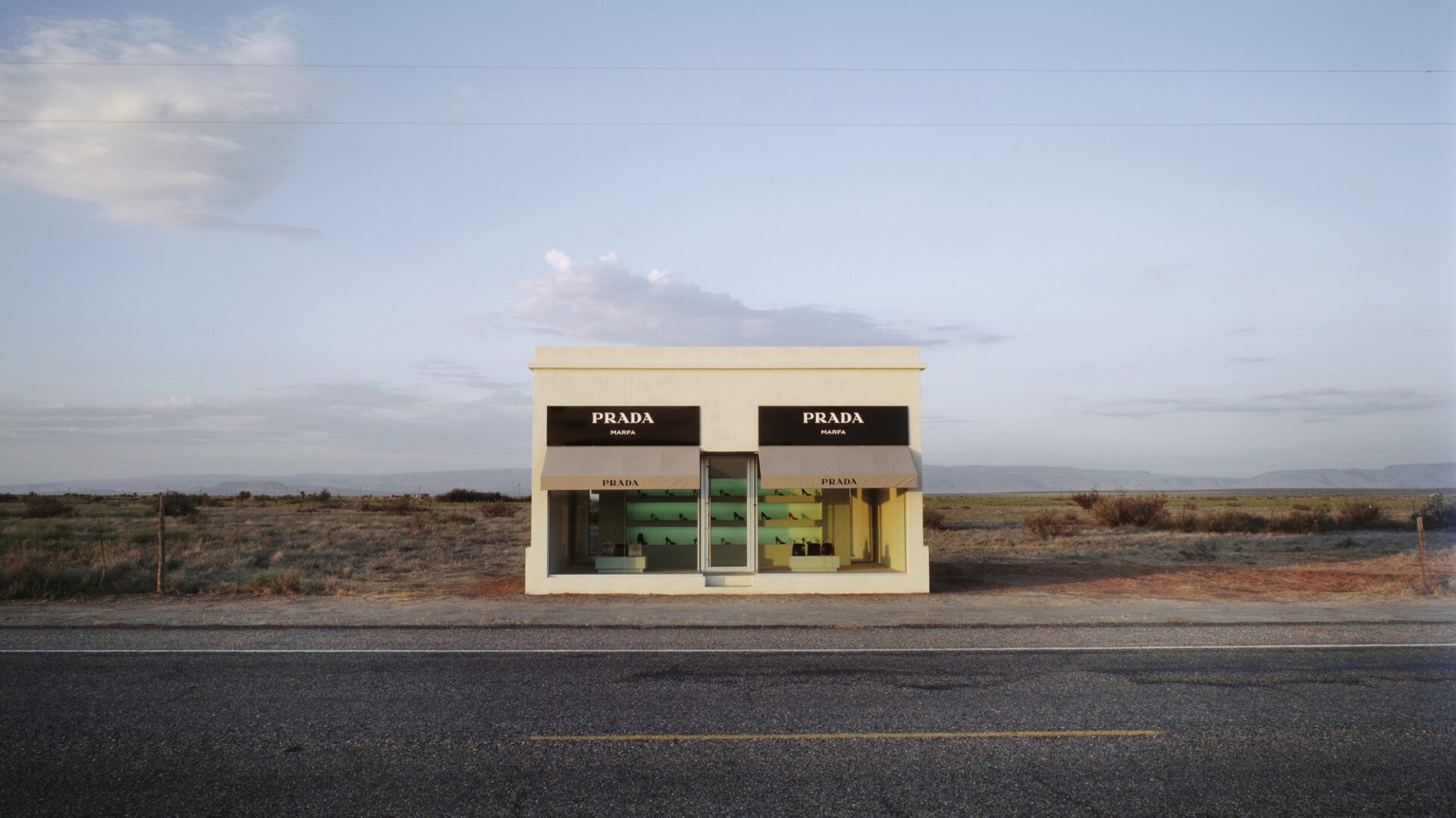Few artist duos have reshaped contemporary art’s spatial lexicon as thoroughly as Michael Elmgreen (b. 1961, Copenhagen) and Ingar Dragset (b. 1969, Trondheim). Since forming their Berlin-based collaboration in 1995, Elmgreen & Dragset have interrogated the built environment with scalpel-sharp wit and a rare conceptual elegance. Their works – at once sculptural, theatrical, and philosophical – dismantle the rituals of exhibition-making while posing urgent questions about identity, alienation and the politics of space.
Arguably, their most iconic gesture remains Prada Marfa (2005), an uncanny replica of a luxury boutique installed in the Texan desert. At first glance, the piece reads as surreal satire – a retail mirage framed by sand and sky. However, Prada Marfa is more than provocation. It is a monument to capitalist absurdity and the fragility of symbols. By staging a sealed Prada storefront in the middle of nowhere, complete with genuine handbags and shoes, the duo confronted viewers with an existential riddle: what happens when luxury loses its context? In the two decades since, the work has only grown in cultural relevance, reflecting the tensions between global consumerism and regional specificity, between surface and substance. It remains a locus of irony and pilgrimage in equal measure.
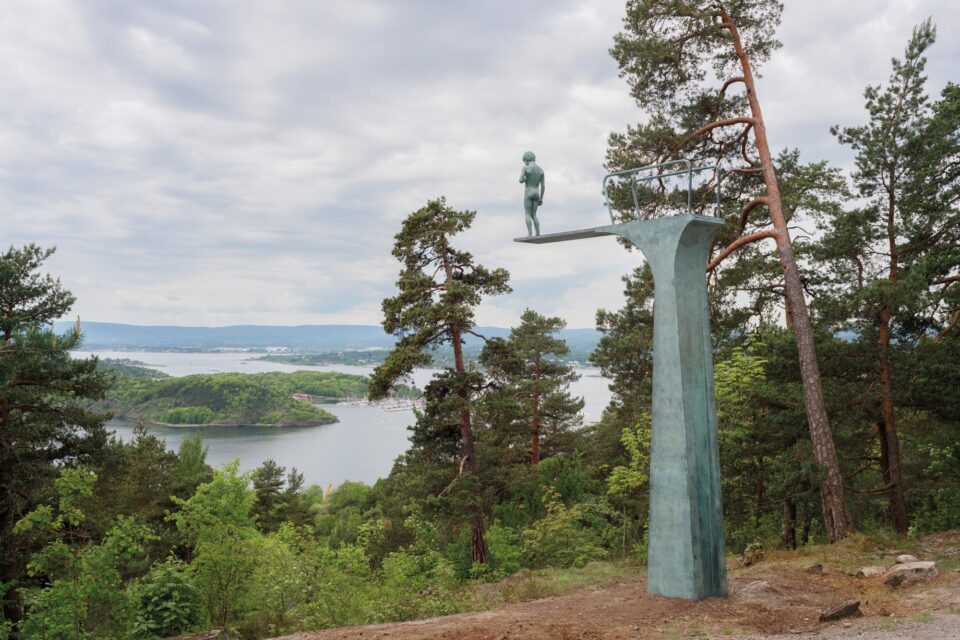
This interest in destabilising space – whether social, psychological or architectural – runs throughout Elmgreen & Dragset’s practice. From Short Cut (2003), a car-and-caravan hybrid seemingly burrowing through gallery floors, to Van Gogh’s Ear (2016), a monumental swimming pool installed upright outside Rockefeller Center, their oeuvre often draws on the absurd to articulate deeper truths. In these interventions, the banal becomes estranged; the everyday is rendered theatrical.
Their new exhibition, The Alice in Wonderland Syndrome, on view at Pace Gallery Los Angeles from 13 September to 25 October, marks the duo’s first solo outing in the city and their fourth with the gallery. The show coincides with the 30th anniversary of their collaboration and the 20th anniversary of Prada Marfa – a temporal pairing that underscores their sustained commitment to scale, illusion, and the phenomenology of art. For this two-part exhibition, Elmgreen & Dragset radically reengineer Pace’s gallery architecture. The main space houses full-scale works; the adjoining gallery becomes a half-size replica, complete with downsized versions of the same sculptures. Inspired by the neurological disorder known as Alice in Wonderland Syndrome – where perceptions of size and distance are distorted – the show asks: how much of reality is determined by proportion, and what happens when that proportion is thrown off-kilter?
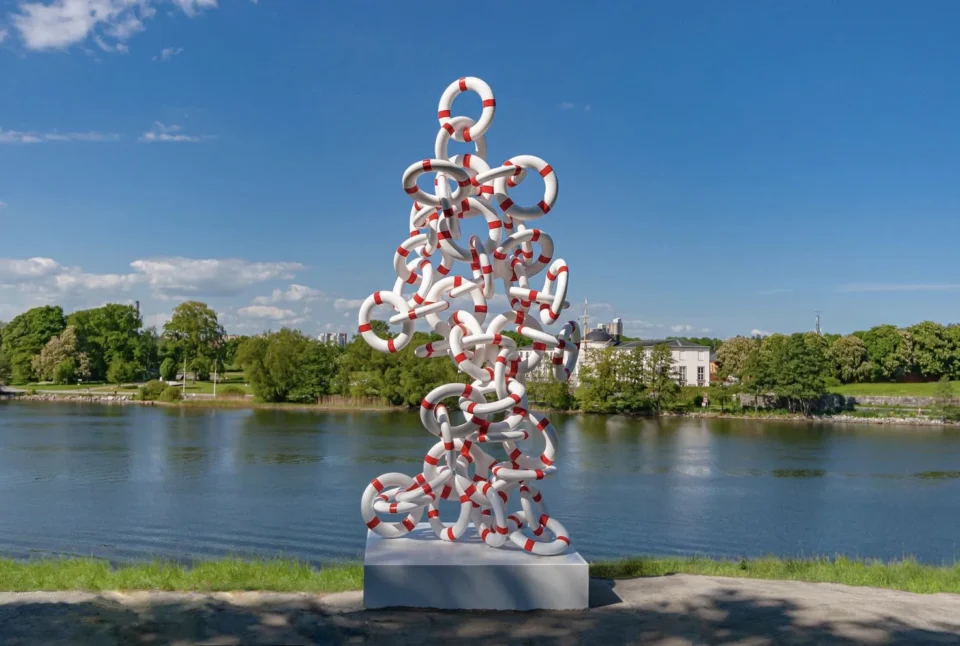
The uncanny begins at the threshold. A hyperreal sculpture of a slumped gallery assistant greets visitors, her posture suggesting sleep or perhaps defeat. Beyond her lies a dreamscape in flux – cloud fragments, mirrored skies, and digital disconnection cast in Carrara marble. In one striking work, two male figures embrace while wearing VR headsets: intimate, yet utterly estranged. In another, a lone youth sits lost in his own soundscape, earbuds sealing him off from the ambient world.
The exhibition’s conceptual core lies in the Sky Target series – mirror-polished steel discs painted with cloudscapes that double as self-reflective portals. These works fracture the line between representation and participation, rendering the viewer both observer and subject. Nearby, “stripe paintings” interweave contrails and mirrored bands, disrupting visual continuity and invoking a sense of drifting time. Across both rooms, the duplication of space creates a mise en abyme – a doubling within a doubling – evoking the layered anxieties of our digitized perception.
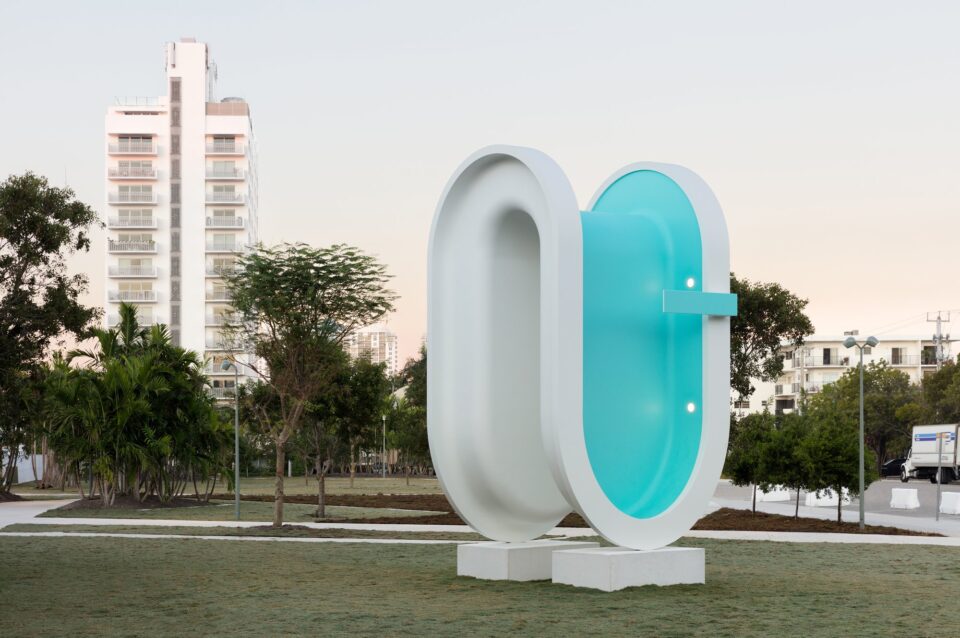
In this sense, Elmgreen & Dragset’s work aligns with a lineage of contemporary artists who use scale and space as emotional registers. British artist Rachel Whiteread, for instance, casts absence as presence, turning negative space into memorial. The architectural uncanny also pulses through the work of Do Ho Suh, whose translucent fabric structures reimagine displacement and memory. Like Elmgreen & Dragset, Suh manipulates physical scale to explore psychological terrain. Similarly, Laure Prouvost engages absurdity and narrative rupture to unseat linear logic, often blending fantasy and tactile form to question cultural hierarchies. Whilst each of these artists forges a distinct path, they share a critical investment in the politics of perception – how we orient ourselves within the spaces we build, and how those spaces, in turn, shape our interior lives. What distinguishes Elmgreen & Dragset is their enduring theatricality. Their installations often feel like dream sequences or stage sets abandoned mid-performance. Nothing is quite what it seems, yet everything is rendered with forensic clarity.
In a culture increasingly mediated through screens, where even our most visceral experiences are filtered and flattened, The Alice in Wonderland Syndrome offers a rare recalibration. It does not offer escape so much as a mirror – distorted, perhaps, but illuminating. The artists tap into a contemporary condition marked by disorientation, solitude, and the disintegration of shared scale. They remind us that space is never neutral. Whether public or private, architectural or virtual, it is always loaded – with desire, exclusion, memory or myth. Ultimately, this exhibition is not about trickery. It is about attentiveness. The shrinking and doubling, the reflective skies, the immersive dream logic, all function as tools for reckoning with our shrinking sense of embodiment in a world dominated by simulation. Through marble, mirrors and architectural mimicry, Elmgreen & Dragset invite us to question what we take for real and how easily that reality can shift.
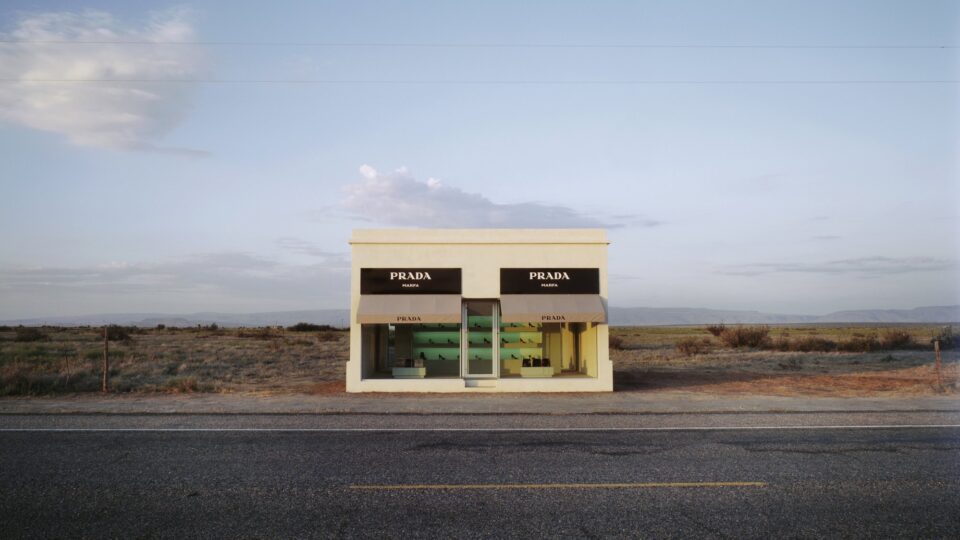
In Los Angeles – a city built on illusion, performance and spatial contradiction – the exhibition arrives with an unsettling clarity. As immigration protests surge across the city and the National Guard once again takes to the streets, echoes of the 1992 riots following the Rodney King verdict reverberate through the present moment. In this climate of heightened tension and unresolved histories, The Alice in Wonderland Syndrome resonates as more than an immersive installation – it becomes a disquieting reflection of collective distortion and fractured realities. Thirty years into their collaboration, Elmgreen & Dragset remain attuned to the unseen forces that shape our lives, asking us to navigate a world perpetually resizing itself around our bodies, identities and beliefs.
Elmgreen & Dragset: The Alice in Wonderland Syndrome is at Pace Gallery, Los Angeles from 13 September – 25 October 2025: pacegallery.com
Words: Anna Müller
Image credits:
1&5. Elmgreen & Dragset, Prada Marfa, 2005, Adobe bricks, plaster, aluminium frames, glass, panes, MDF, paint, carpet, canvas, Prada shoes and bags, 480 x 760 x 470 cm, courtesy Art Production Fund, New York; Ballroom Marfa, Marfa; the artists, photography by James Evans & Lizette Kabré, on permanent display, Marfa, Texas, USA © Elmgreen & Dragset.
2. Elmgreen & Dragset, Dilemma, 2017, Patinated bronze, stainless steel, 520 x 300 x 47 cm, courtesy the artists, Ekebergparken, photography by Florian Holzerr, on permanent display, Ekebergparken, Oslo, Norway © Elmgreen & Dragset.
3. Elmgreen & Dragset, Life Rings, 2021, Stainless steel, lacquer, concrete, 755 x 325 x 300 cm, courtesy Princess Estelle Cultural Foundation, photography by Ruth Anna Eriksson © Elmgreen & Dragset.
4. Elmgreen & Dragset, Bent Pool, 2019, Steel, stainless steel, aluminum, concrete, lacquer, lights, 600 x 392 x 344 cm, courtesy the artists, City of Miami Beach, photography by Andrea Rosetti, on permanent display, Pride Park, Miami Beach, USA © Elmgreen & Dragset.


